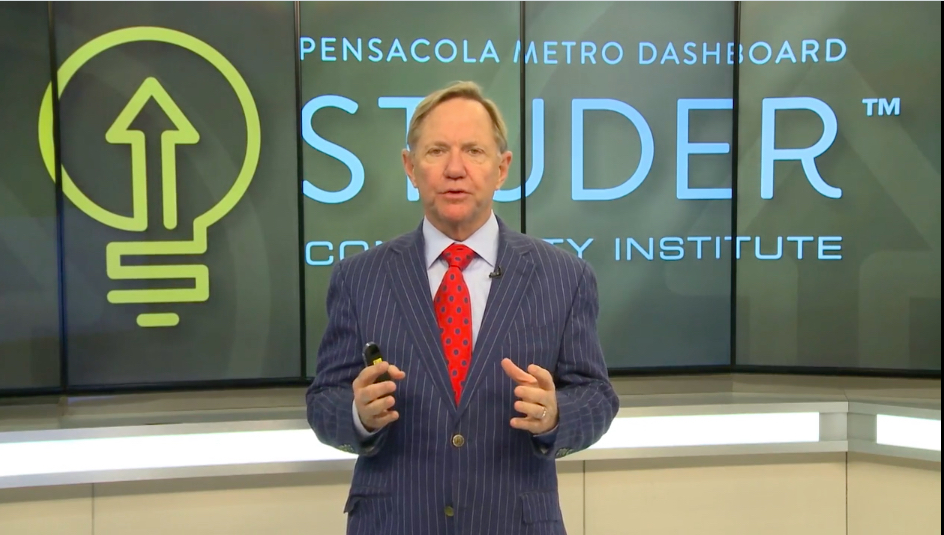Identifying common barriers that prevent growth
- March 29, 2017
- / Quint Studer
- / training-development,quint-studer

SCI founder Quint Studer reviews updated information for the 2016 Pensacola Metro Dashboard.
Finding the desire to improve a business can be relatively easy.
I’ve interacted with thousands of people in leadership positions at school districts, small and large businesses, and in community/government roles.
So you have all these passionate people looking to make positive change, but what gets in the way of them doing so? An owner or CEO wants to improve his company, but by year’s end, it stays pretty much the same. Yes, there may be a burst of action and a rash of initiatives. (Think January at the local gym as New Year’s resolutions begin.)
However, when the dust settles, maybe after a brief period of improvement, the organization is back where it started. Even worse, the employees have seen another promise not fulfilled.
To start to really sustain the gains, let’s identify four common barriers that prevent this growth from taking hold:
1. “Everyone is struggling with this.”
“The data is old.”
“We need more staff.”
“We need more money.”
“I was waiting for (fill in the blank).”
The best way to move away from this barrier is to find examples of organizations in similar situations that are performing better. Or even look in house and find leaders in the organization who, despite the same environment, are having success. As the Heath Brothers wrote in their book, Switch, when change is hard, study those who are having success, learn from it and transfer those practices.
I was recently talking with a CEO of a large organization who has 29 percent employee turnover. That means the entire workforce could turn over every three-plus years. (It may not mean all positions turn over in that span, but some positions are in constant change.) This high level of turnover in this industry impacts operations across the board. However, this specific organization is part of a larger company, and when compared to the others inside the company, this turnover rate is in the middle of the pack.
So what can happen? This CEO could use the rationalization that “we’re not that bad.” However, what keeps them from being better? I bet there are managers in that organization who have low-turnover departments.
In education, we can spend time studying the children in poverty who drop out. Using the Heath Brothers’ example, it is better to spend the time on children in poverty who did not drop out.
Rationalization is a silent killer in attaining better performance.
- Is it truly better to blame someone or something than take ownership? There are, of course, times when things outside an employee’s control do impact performance. Key words to watch for is them or they.
- Save for a few exceptions, for the most part all organizations deal with the same external factors. Weather is obvious. This will impact any outside event. Most of the time, though, blame does nothing to improve results.
- We can blame the customers for high expectations, the demands of certain work groups, the media, the government or anything that comes to mind. Once blame is imposed we become a victim. This means we give away the responsibility to make the situation better.
“It has always been that way.”
“Same old, same old.”
“It is not that bad, everyone is like that.”
“Nothing I can do about it.”
This is when leaders just can’t look at themselves. As one person said to me, “Denial is not a river, but a current in one’s mind that keeps one from acting.” At times the key is to accept the current situation, but that does not mean accepting nothing can be done.
What breaks through denial? Objective data can help. Caring friends who care enough to point out the facts. Some decisions aren’t made because they want to avoid the pain of going through with it, but that’s until the situation just gets so bad that something needs to be done. It seems every time I hear from a leader who has made a difficult decision, his learning is typically, “I wish I had done it sooner.”
- Failure to take organizational performance personally. An organization had received its employee engagement results recently and they were not good at all. I was with the system CEO, and this CEO pointed out the top leader of one of the key areas of the system and said that this leader was taking the results personally and she was coaching him to not take it so personally.
My answer? He should take them personally. In fact, until the results are taken personally they will not get better. Rationalization, blame and denial are those items that keep a leader from taking it personally.
Once a person accepts the results and owns them then the next steps are building the skill set in oneself and in the organization to achieve great results.
 CivicCon launches with a look at good growth in cities
CivicCon launches with a look at good growth in cities
 Building stronger brains one baby, one parent at a time
Building stronger brains one baby, one parent at a time
 SCI debuts commercial on Early Learning City
SCI debuts commercial on Early Learning City
 Entrecon: World class speakers and an opportunity to sharpen skills
Entrecon: World class speakers and an opportunity to sharpen skills
 PYP Quality of Life survey 2017
PYP Quality of Life survey 2017
 EntreCon Pensacola 2016: A look back
EntreCon Pensacola 2016: A look back
 Leadership tip: getting better employee takeaways
Leadership tip: getting better employee takeaways
 Leadership tip: be interested instead of interesting
Leadership tip: be interested instead of interesting
 Leadership tip: delivering difficult messages
Leadership tip: delivering difficult messages
 Brain Bags boost Arc, Early Childhood Court programs
Brain Bags boost Arc, Early Childhood Court programs